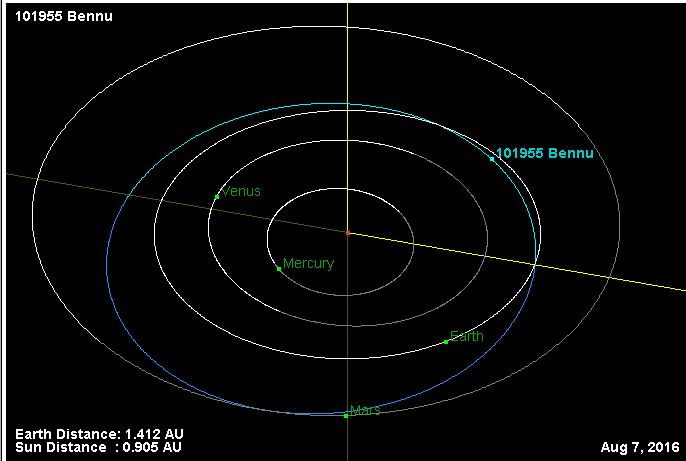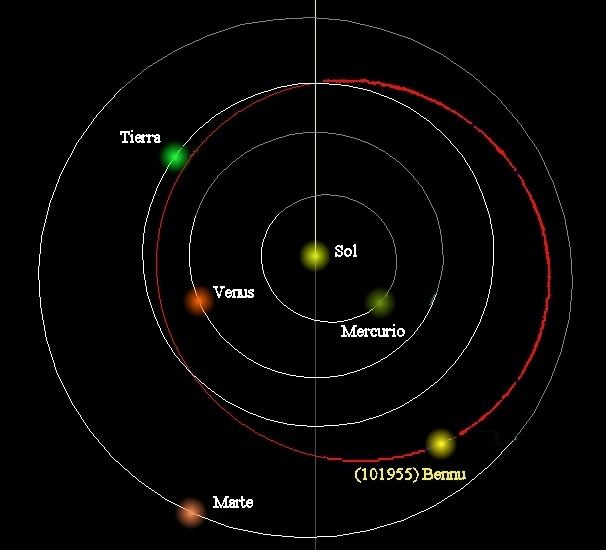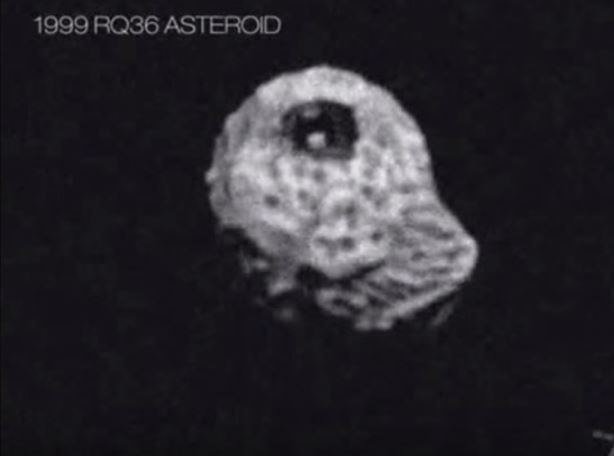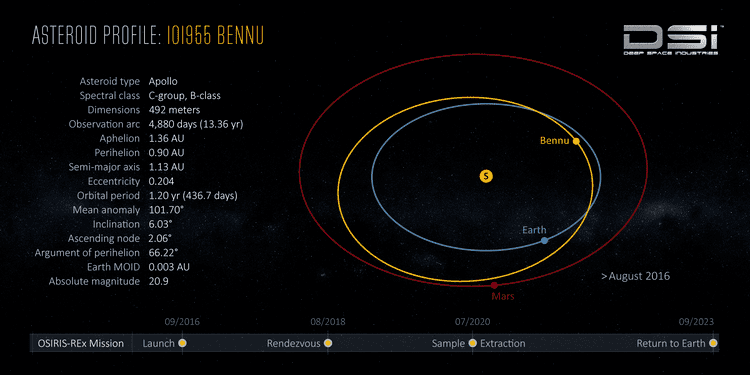Discovered by LINEAR Discovery date 11 September 1999 Pronunciation /bɛˈnuː/ Orbital period 438 days Orbits Sun Asteroid group Apollo asteroid | Discovery site Lincoln Lab's ETS MPC designation 101955 Bennu Alternative names 1999 RQ36 Discovered 11 September 1999 Named after Bennu | |
 | ||
Discoverer Lincoln Near-Earth Asteroid Research Similar 162173 Ryugu, 25143 Itokawa, 99942 Apophis | ||
101955 Bennu (provisional designation 1999 RQ36) is a carbonaceous asteroid in the Apollo group that was discovered by the LINEAR Project on September 11, 1999. It is a potential Earth impactor that is listed on the Sentry Risk Table with the second-highest rating on the Palermo Technical Impact Hazard Scale, due to a 1-in-2,700 chance of impacting Earth in the late 22nd century. It is the planned target of the OSIRIS-REx mission which is intended to return samples to Earth in 2023 for further study.
Contents
- Alien structure on 1999rq36 101955 bennu asteroid pyramid on asteroid p
- Physical description
- Origin and evolution
- Possible Earth impact
- Long term fate
- Selection for OSIRIS REx mission
- Name
- References

101955 Bennu has a mean diameter of approximately 492 m (1,614 ft; 0.306 mi) and has been observed extensively with the Arecibo Observatory Planetary Radar and the Goldstone Deep Space Network.

Alien structure on 1999rq36 101955 bennu asteroid pyramid on asteroid p
Physical description

Asteroid Bennu has a roughly spheroidal shape, which resembles a spinning top. The direction of rotation about its axis is retrograde with respect to its orbit. Bennu has a fairly smooth shape with one prominent 7001100000000000000♠10–20 m boulder on its surface, in the southern hemisphere.

There is a well-defined ridge along the equator of asteroid Bennu. This presence of this ridge suggests that fine-grained regolith particles have accumulated in this area, possibly due to its low gravity and fast rotation.

Observations of this minor planet by the Spitzer Space Telescope in 2007 gave an effective diameter of 7002484000000000000♠484±10 m, which is in line with other studies. It has a low visible geometric albedo of 6998460000000000000♠0.046±0.005. The thermal inertia was measured and found to vary by ±19% during each rotational period. The data suggest that the regolith grain size is moderate, ranging from several millimeters up to a centimeter, and evenly distributed longitudinally. No emission from a potential dust coma has been detected around asteroid Bennu, which puts a limit of 106 g of dust within a radius of 4750 km.

Astrometric observations between 1999 and 2013 have demonstrated that 101955 Bennu is influenced by the Yarkovsky effect, causing the semimajor axis to drift on average by 7002284000000000000♠284±1.5 m/year. Analysis of the gravitational and thermal effects has given a bulk density of ρ = 7003126000000000000♠1260±70 kg/m3, which is only slightly denser than water. Therefore, the predicted macroporosity is 7001400000000000000♠40±10%, suggesting that the interior has a rubble pile structure. The estimated mass is 7010780000000000000♠(7.8±0.9)×1010 kg.

Photometric observations of 101955 Bennu in 2005 yielded a synodic rotation period of 7004154458000000000♠4.2905±0.0065 h. It has a B-type classification, which is a sub-category of carbonaceous asteroids. Measurements over a range of phase angles showed a phase function slope of 0.040 magnitudes per degree, which is similar to other near-Earth asteroids with low albedo.
Origin and evolution
The carbonaceous material that compose asteroid Bennu originally came from dying stars such as red giants and supernovae. According to the accretion theory, this material came together 4.5 billion years ago during the birth of the Solar System.
Asteroid Bennu's basic mineralogy and chemical nature would have been established during the first 10 million years of the Solar System's formation, where the carbonaceous material underwent some geologic heating and chemical transformation into more complex minerals. Bennu probably began in the inner main asteroid belt as a fragment from a larger body with a diameter of 100 km. Simulations suggest a 70% chance it came from the Polana family and a 30% chance it derived from the Eulalia family.
Subsequently, the orbit drifted as a result of the Yarkovsky effect and mean motion resonances with the giant planets, such as Jupiter and Saturn. Various interactions with the planets in combination with the Yarkovsky effect modified the asteroid, possibly changing its spin, shape, and surface features.
Possible Earth impact
On average, an asteroid with a diameter of 500 m (1,600 ft; 0.31 mi) can be expected to impact Earth about every 130,000 years or so. A 2010 dynamical study by Andrea Milani and collaborators predicted a series of eight potential Earth impacts by Bennu between 2169 and 2199. The cumulative probability of impact is dependent on physical properties of Bennu that were poorly known at the time, but was not found to exceed 0.071% for all eight encounters. The authors recognized that an accurate assessment of 101955 Bennu's probability of Earth impact would require a detailed shape model and additional observations (either from the ground or from spacecraft visiting the object) to determine the magnitude and direction of the Yarkovsky effect.
The publication of the shape model and of astrometry based on radar observations obtained in 1999, 2005, and 2011, made possible an improved estimate the Yarkovsky acceleration and a revised assessment of the impact probability. The current (as of 2014) best estimate of the impact probability is a cumulative probability of 0.037% in the interval 2175 to 2196. This corresponds to a score on the Palermo scale of −1.70. If an impact were to occur, the expected kinetic energy associated with the collision would be 1200 megatons in TNT equivalent.
Long term fate
In the span of time of concern to present-day people, the fate of 101955 Bennu that looms most significant is collision with the Earth. In the much longer term (many millions of years), it is more likely that 101955 Bennu will be destroyed by some other cause. Lauretta et al. report the results of a computer simulation:
The orbit of Bennu is intrinsically dynamically unstable, as are those of all NEOs. In order to glean probabilistic insights into the future evolution and likely fate of Bennu beyond a few hundred years, we tracked 1000 virtual “Bennus” for an interval of 300 Myr with the gravitational perturbations of the planets Mercury–Neptune included. Our results ... indicate that Bennu has a 48% chance of falling into the Sun. There is a 10% probability that Bennu will be ejected out of the inner solar system, most likely after a close encounter with Jupiter. The highest impact probability for a planet is with Venus (26%), followed by the Earth (10%) and Mercury (3%). The odds of Bennu striking Mars are only 0.8% and there is a 0.2% chance that Bennu will eventually collide with Jupiter.
Selection for OSIRIS-REx mission
The OSIRIS-REx mission of NASA's New Frontiers Program was launched towards 101955 Bennu on September 8, 2016. It is expected to reach the asteroid in August 2018 and return samples to Earth in 2023.
Bennu was selected from over 7005500000000000000♠500000 known asteroids by the OSIRIS-REx selection committee. The primary restraint for selection was close proximity to Earth, due to the low Δv required to reach it from Earth orbit. The criteria stipulated an asteroid in an orbit with low eccentricity, low inclination, and an orbital radius of 7011119678296560000♠0.8–1.6 AU.
Furthermore, the candidate asteroid for a sample-return mission must have loose regolith on its surface, which implies a diameter greater than 200 meters. Asteroids smaller than this typically spin too fast to retain dust or small particles.
Finally, a desire to find an asteroid with pristine carbon material from the early solar system, possibly including volatile molecules, organic compounds and amino acids reduced the list further.
With the above criteria applied, five asteroids remained as candidates for the OSIRIS-REx mission and Bennu was chosen, in part due to its potentially hazardous orbit.
Name
The name Bennu was selected from more than eight thousand student entries from dozens of countries around the world who entered a "Name That Asteroid!" contest run by the University of Arizona, The Planetary Society, and the LINEAR Project. Third-grade student Michael Puzio from North Carolina proposed the name in reference to the Egyptian mythological bird Bennu. To Puzio, the OSIRIS-REx spacecraft with its extended TAGSAM arm resembles the Egyptian deity, which is typically depicted as a heron.
